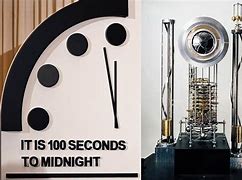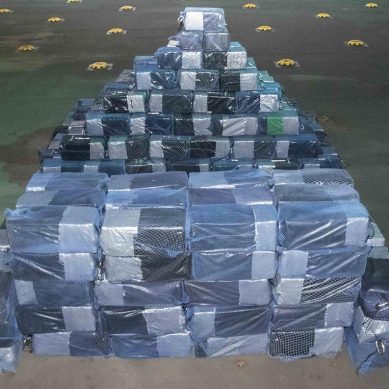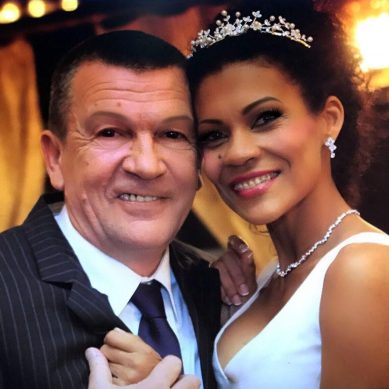
My mom and dad, Elizabeth McAlister and Philip Berrigan, a former nun and a priest, refused to pay “war taxes,” trespassed onto military installations to protest our world-ending ways, held vigils at weapons manufacturing plants and protested during the stockholder meetings of giant weapons-making corporations, while taking care of the victims of skewed US policies by organising soup lines and opening their doors to the unhoused.
By reminding me of where the hands on the Doomsday Clock stood at any moment, my dad helped me integrate concerns about nuclear weapons into my daily life. He helped me measure out the energy I had for any worry.
I mean, why fork over $8 (now $28?) at a movie box office to get scared by a horror story on the celluloid screen when the real world is scary enough for free? So, nuclear timekeeping started in 1947 at seven minutes to midnight.
By 1949, as the Cold War heated up and the Soviet Union got the bomb, the hands on that clock were moved to three minutes to midnight, code for distinctly too close! As the Bulletin of the Atomic Scientists wrote after Russia exploded its first nuclear device, “We think that Americans have reason to be deeply alarmed and prepare for grave decisions.” The nuclear arms race was off and running.
In 1953, after the US and the Soviets developed and tested massive hydrogen bombs, those hands were moved to two minutes.
In 1960, sustained international cooperation and the successful negotiation of arms control treaties between the superpower rivals compelled the scientists to move the clock hands back to seven minutes to midnight.
In 1963, in the wake of the Cuban missile crisis and the terror of near-nuclear war, the US and USSR signed new agreements, ending atmospheric nuclear tests. The world sighed with relief as the clock was moved back to 12 minutes.
But in 1968, as the Vietnam War fanned global tensions, the Soviets expanded their nuclear arsenal, and France and China both developed nuclear weapons, it was at seven minutes again. 1969 brought another sigh of relief as the Nuclear Non-Proliferation Treaty (NPT) was signed and the nations with such weaponry committed to future nuclear disarmament talks. The clock inched back to 10 minutes.
In 1972, when the US and Soviet Union signed the disarmament agreement that came to be known as the Strategic Arms Limitation Treaty or SALT, the clock made it to 12 minutes.
In 1974, however, India tested a nuclear device painfully code-named “Smiling Buddha” and that minute hand was moved to nine again. I was born just a few weeks before that Indian test, which spurred neighbour and rival Pakistan to launch its own nuclear programme.
By the following summer, my parents would carry my infant brother and me as they marched with friends, hauling full-sized replicas of the nuclear weapons that had destroyed Hiroshima and Nagasaki through the streets of Washington, every day for almost a week to mark the 30th anniversary of the atomic bombings.
In 1981, as the Soviets continued their war in Afghanistan and Americans elected Ronald Reagan as president, the clock ominously moved to four minutes. I was seven and my brother six when our father was sentenced to 10 years in jail (later reduced) for his part in a 1980 action.
A group that called itself the Plowshares Eight had walked into the General Electric Space Technology Centre in King of Prussia, Pennsylvania, with the early morning rush of workers. There, they symbolically disarmed some model nuclear weapons. Their trial was later made into a movie starring Martin Sheen (with my dad playing himself).
In 1984, the clock was moved to three minutes to midnight as President Reagan pumped money into Star Wars technology as a way to win a future nuclear war. Just a month after I turned 10, my mom went on trial for her Plowshares action a year earlier at Griffiss Air Force base in upstate New York. That summer, my family and their friends also tried to maintain a round-the-clock presence at the Pentagon concourse.
In 1988, the Bulletin‘s scientists reset the Doomsday Clock at six minutes to midnight as the work of a growing global antinuclear movement started to deliver dividends in agreements to cut back the number of deployed long-range nuclear weapons. That summer, when I was 14, we built a rough, shed-like house and brought it to the Pentagon Parade Ground to call for “homes, not bombs.” We stayed all night and watched the rats take over the Pentagon grounds as it grew dark.
By 1990, in the wake of the fall of the Berlin Wall, the clock was readjusted to 10 minutes to midnight, the furthest from disaster since 1968.
In 1991, in the wake of the Cold War, the US and Russia signed the Strategic Arms Reduction Treaty (START) and began to cut back their nuclear arsenals as the Soviet Union faded into history. Appropriately enough, the Bulletin moved the clock to a breath-taking 17 minutes to midnight, writing: “The illusion that tens of thousands of nuclear weapons are a guarantor of national security has been stripped away.”
In 1995, a close call and human error led the scientists to nudge the clock to 14 minutes and, in 1998, nine minutes, while calling on the United States, Russia, and other nuclear states to “fully commit” to “control the spread of nuclear weapons.”
- By Frida Berrigan, author of It Runs in the Family: On Being Raised by Radicals and Growing into Rebellious Motherhood











